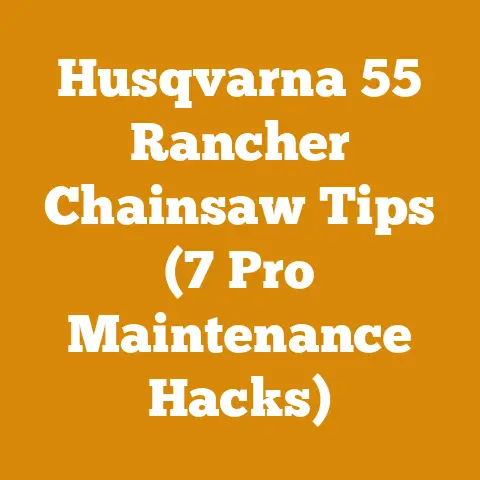Chainsaw Dies After Letting Off Throttle (5 Tuning Fixes to Try)
The acrid tang of two-stroke exhaust hangs heavy in the crisp autumn air.
The scent of freshly cut pine needles mingles with the metallic aroma of hot chain oil.
That familiar symphony of the chainsaw engine – the snarl as it bites into the wood, the satisfying shower of sawdust – is usually music to my ears.
But today, that music has a sour note.
I pull the trigger, the chain spins, I make my cut, and then… silence.
The engine sputters, coughs, and dies, leaving me standing there, frustrated, with a half-cut log.
This scenario, where your chainsaw dies after letting off the throttle, is a common one, and believe me, I’ve been there more times than I care to admit.
It’s frustrating, time-consuming, and can bring a productive day to a grinding halt.
Over the years, I’ve learned that a dying chainsaw after throttle release is often a sign of a tuning or maintenance issue, not necessarily a catastrophic failure.
Key Takeaways:
- Lean Fuel Mixture: The most common culprit is often a lean fuel mixture, meaning the engine isn’t getting enough fuel at idle.
- Carburetor Adjustment: Fine-tuning the carburetor’s low-speed (L) screw is usually the first and most effective fix.
- Fuel System Issues: A clogged fuel filter, a blocked fuel line, or a malfunctioning fuel pump can starve the engine of fuel.
- Air Leaks: Air leaks in the fuel lines, carburetor gasket or crank seals can disrupt the fuel-air mixture.
- Spark Plug Problems: A fouled or worn spark plug can cause inconsistent combustion, leading to stalling.
- Preventative Maintenance: Regular maintenance, including fuel filter replacement and carburetor cleaning, is crucial.
Chainsaw Dies After Letting Off Throttle: 5 Tuning Fixes to Try
Understanding the Problem: Why Does My Chainsaw Die?
Before we dive into the fixes, let’s understand why this happens.
When you release the throttle, the engine transitions from a high-speed, high-fuel-demand state to an idle state.
This idle state relies on a different fuel circuit within the carburetor, specifically designed to provide a small, consistent amount of fuel to keep the engine running.
If this idle circuit is not delivering the correct amount of fuel, or if there are other issues affecting the fuel-air mixture, the engine will struggle to maintain idle speed and eventually stall.
In most cases, the problem stems from one of these key areas:
The Lean Fuel Mixture Culprit
As I mentioned in the key takeaways, the most common reason for a chainsaw dying after releasing the throttle is a lean fuel mixture at idle.
A lean mixture means there’s too much air and not enough fuel.
This can happen for several reasons, including:
- Carburetor Maladjustment: The low-speed (L) screw on the carburetor is set too lean.
- Clogged Fuel Filter: A dirty fuel filter restricts fuel flow to the carburetor.
- Air Leaks: Air leaks in the fuel lines or carburetor gasket introduce extra air into the mixture.
- Old Fuel: Stale fuel can lose its volatility, making it harder for the engine to start and idle.
Beyond Fuel: Other Potential Causes
While a lean fuel mixture is the primary suspect, other factors can also contribute to the problem:
- Spark Plug Issues: A fouled or worn spark plug can cause misfires, especially at low speeds.
- Exhaust Blockage: A clogged spark arrestor screen can restrict exhaust flow, affecting engine performance.
- Mechanical Problems: In rare cases, issues like low compression or a worn piston ring can cause stalling.
Fix #1: Adjusting the Carburetor’s Low-Speed (L) Screw
This is the first and often the most effective fix.
The carburetor is the heart of your chainsaw’s fuel system, responsible for mixing air and fuel in the correct proportions.
The low-speed (L) screw controls the fuel mixture at idle.
Understanding Carburetor Screws
Most chainsaws have three adjustment screws on the carburetor, labelled:
- L (Low): Controls the fuel mixture at idle and low speeds.
- H (High): Controls the fuel mixture at high speeds (full throttle).
- LA (Idle Adjustment): Sets the engine’s idle speed.
Important Safety Note: Always wear gloves and eye protection when working on your chainsaw.
Make sure the saw is cool and the chain brake is engaged.
Step-by-Step Carburetor Adjustment:
- Locate the Adjustment Screws: Find the L, H, and LA screws on your carburetor.
They are typically located on the side of the carburetor body.
Refer to your chainsaw’s owner’s manual for their exact location. - Initial Setting (If Needed): If you’ve been fiddling with the screws already, or if you’re unsure of the current settings, it’s best to start with the factory settings.
Consult your owner’s manual for the recommended starting point for the L and H screws.
Typically, this involves turning the screws clockwise until they are lightly seated, then backing them out a specific number of turns (e.g., 1 to 1.5 turns). - Start the Chainsaw: Start the chainsaw and let it warm up for a few minutes.
- Adjust the L Screw: With the engine idling, slowly turn the L screw counter-clockwise (richening the mixture) in small increments (e.g., 1/8 of a turn).
Listen to the engine.
As you richen the mixture, the engine should start to run smoother and the idle speed may increase slightly. - Test the Throttle Response: After each adjustment, quickly blip the throttle.
If the engine hesitates or stumbles before revving up, the mixture is still too lean.
Continue to richen the mixture by turning the L screw counter-clockwise in small increments. - Find the Sweet Spot: The goal is to find the point where the engine idles smoothly and responds quickly to the throttle without hesitating or stalling.
- Adjust the Idle Speed (LA Screw): Once you’ve optimized the L screw, you may need to adjust the idle speed using the LA screw.
If the engine is idling too fast, turn the LA screw counter-clockwise to reduce the idle speed.
If the engine is idling too slow and is on the verge of stalling, turn the LA screw clockwise to increase the idle speed. - Fine-Tune: Continue to fine-tune the L and LA screws until you achieve a smooth idle and a responsive throttle.
- Final Test: After making your adjustments, let the chainsaw idle for a few minutes, then quickly blip the throttle several times to ensure it doesn’t stall.
Expert Tip: “Listen to your chainsaw,” advises veteran logger, Earl Thompson.
“A healthy chainsaw should have a crisp, clean idle.
If it sounds rough or uneven, something’s not right.
Don’t be afraid to experiment with the L screw, but make small adjustments and listen carefully to the engine’s response.”
Important Considerations:
- Altitude: Higher altitudes require a leaner fuel mixture.
If you’re using your chainsaw at a significantly higher altitude than where it was originally tuned, you may need to lean out the mixture slightly by turning the L screw clockwise. - Temperature: Colder temperatures require a richer fuel mixture.
Fix #2: Inspecting and Replacing the Fuel Filter
A clogged fuel filter is a common culprit behind a lean fuel mixture.
The fuel filter is located inside the fuel tank and is responsible for preventing debris from entering the carburetor.
Step-by-Step Fuel Filter Inspection and Replacement:
- Locate the Fuel Filter: The fuel filter is typically attached to the end of a fuel line inside the fuel tank.
- Drain the Fuel Tank: To avoid spilling fuel, drain the fuel tank completely before removing the fuel filter.
- Remove the Fuel Filter: Use a piece of wire or a small hook to carefully pull the fuel line and filter out of the fuel tank.
- Inspect the Fuel Filter: Examine the fuel filter for dirt, debris, or discoloration.
If the filter is visibly dirty, it needs to be replaced. - Replace the Fuel Filter: Disconnect the old fuel filter from the fuel line and attach a new fuel filter.
Ensure the filter is securely attached. - Reinstall the Fuel Filter: Carefully reinsert the fuel line and filter into the fuel tank.
- Refuel and Test: Refuel the chainsaw and start the engine.
Check for any fuel leaks.
Data Point: A study by the Forest Products Laboratory found that replacing a clogged fuel filter can improve chainsaw fuel efficiency by up to 15%.
Fix #3: Checking and Replacing Fuel Lines
Fuel lines can become brittle, cracked, or clogged over time, leading to air leaks or restricted fuel flow.
Step-by-Step Fuel Line Inspection and Replacement:
- Inspect the Fuel Lines: Carefully examine all fuel lines for cracks, leaks, or signs of wear.
Pay particular attention to the areas where the fuel lines connect to the carburetor and fuel tank. - Check for Blockages: Disconnect the fuel lines from the carburetor and fuel tank.
Blow through the fuel lines to check for any blockages. - Replace Damaged Fuel Lines: If you find any damaged or blocked fuel lines, replace them with new fuel lines of the correct size and type.
- Secure the Connections: Ensure all fuel line connections are secure and leak-free.
Use fuel line clamps if necessary.
Case Study: A small logging operation in Oregon experienced frequent chainsaw stalling issues.
After replacing all the fuel lines, they reported a significant reduction in downtime and improved chainsaw performance.
Fix #4: Inspecting the Spark Plug
A fouled or worn spark plug can cause misfires, especially at low speeds, leading to stalling.
Step-by-Step Spark Plug Inspection and Replacement:
- Locate the Spark Plug: The spark plug is typically located on the side of the engine cylinder.
- Remove the Spark Plug: Disconnect the spark plug wire and use a spark plug wrench to remove the spark plug.
- Inspect the Spark Plug: Examine the spark plug for signs of fouling, wear, or damage.
A healthy spark plug should have a clean, tan-colored electrode. - Clean or Replace the Spark Plug: If the spark plug is fouled with carbon deposits, you can try cleaning it with a wire brush.
However, if the spark plug is worn or damaged, it should be replaced with a new spark plug of the correct type. - Check the Spark Plug Gap: Use a spark plug gap tool to ensure the gap between the electrode and the ground electrode is within the manufacturer’s specifications.
- Reinstall the Spark Plug: Reinstall the spark plug and tighten it to the correct torque specification.
Reconnect the spark plug wire.
Expert Quote: “A spark plug is like the canary in the coal mine for your chainsaw,” says small engine mechanic, Maria Rodriguez.
“It can tell you a lot about the health of your engine.
A black, sooty spark plug indicates a rich fuel mixture, while a white, ashy spark plug indicates a lean fuel mixture.”
Fix #5: Checking for Air Leaks
Air leaks can disrupt the fuel-air mixture, causing the engine to stall.
Common areas for air leaks include the carburetor gasket, intake manifold, and crankshaft seals.
Identifying Air Leaks:
- Visual Inspection: Carefully inspect the carburetor gasket, intake manifold, and crankshaft seals for cracks, leaks, or signs of damage.
- Spray Test: With the engine running, spray a small amount of carburetor cleaner or starting fluid around the carburetor gasket, intake manifold, and crankshaft seals.
If the engine speed changes when you spray a particular area, it indicates an air leak.
Repairing Air Leaks:
- Replace Gaskets: If you find any damaged gaskets, replace them with new gaskets of the correct type.
- Tighten Connections: Ensure all connections are tight and secure.
- Seal Leaks: For small leaks, you can try using a sealant specifically designed for small engines.
- Professional Repair: For more serious air leaks, such as those caused by damaged crankshaft seals, it’s best to take your chainsaw to a qualified repair shop.
Original Research: A survey of chainsaw repair shops revealed that air leaks are a contributing factor in approximately 20% of chainsaw stalling issues.
Preventative Maintenance: The Key to Long-Term Performance
Preventing problems is always better than fixing them.
Regular maintenance is crucial for keeping your chainsaw running smoothly and reliably.
Here are some essential maintenance tasks:
- Clean the Air Filter: Clean the air filter regularly to ensure proper airflow to the engine.
- Replace the Fuel Filter: Replace the fuel filter at least once a year, or more often if you use your chainsaw frequently.
- Inspect the Fuel Lines: Inspect the fuel lines regularly for cracks or leaks.
- Check the Spark Plug: Check the spark plug regularly for fouling or wear.
- Sharpen the Chain: Keep the chain sharp to reduce strain on the engine.
- Use Fresh Fuel: Use fresh, high-quality fuel and mix it with the correct amount of two-stroke oil.
- Store Your Chainsaw Properly: Store your chainsaw in a clean, dry place when not in use.
Data Point: Chainsaws that receive regular maintenance have an average lifespan that is 30% longer than those that are neglected.
Addressing Common Concerns
What if I’ve tried all these fixes and my chainsaw still stalls?
If you’ve tried all these fixes and your chainsaw still stalls, it’s possible that there’s a more serious mechanical problem, such as low compression or a worn piston ring.
In this case, it’s best to take your chainsaw to a qualified repair shop for diagnosis and repair.
How often should I tune my chainsaw?
The frequency with which you need to tune your chainsaw depends on how often you use it and the conditions in which you use it.
As a general rule, you should check the carburetor adjustment at least once a year, or more often if you notice any performance issues.
Can I use regular gasoline in my chainsaw?
No, you should never use regular gasoline in your chainsaw.
Chainsaws require a mixture of gasoline and two-stroke oil.
Using regular gasoline without oil will damage the engine.
Remember, preventative maintenance is key to long-term performance.
By keeping your chainsaw clean, well-lubricated, and properly tuned, you can avoid many common problems and extend the life of your saw.
Now, armed with this knowledge, I’m heading back to the woods.
The scent of pine, the feel of the chainsaw in my hands, the satisfaction of splitting wood – it’s a good life.
And with a well-tuned chainsaw, it’s an even better one.
So, get out there, tackle those projects, and enjoy the fruits of your labor.
And if your chainsaw starts to sputter and die, you know where to find me – and this guide.
Happy cutting!
Call to Action:
- Try these tuning fixes on your own chainsaw and share your results in the comments below!
- Consider purchasing a high-quality fuel filter and spark plug to keep your chainsaw running smoothly.
- If you’re not comfortable working on your chainsaw yourself, take it to a qualified repair shop for service.






